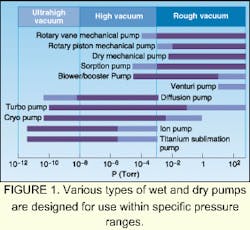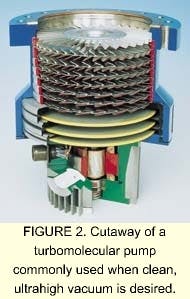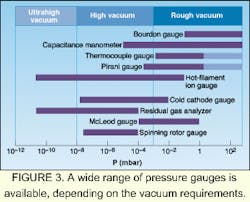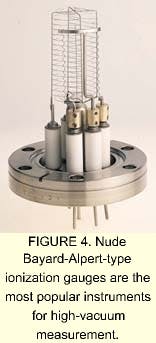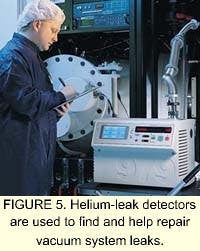Producing 'nothing' demands attention to detail
Philip A. Lessard and William G. Foley
An understanding of vacuum technology and appropriate system maintenance are essential for achieving repeatable vacuums consistently.The production of even a "rough" vacuum requires the removal of 99.999% of the residual gas in a closed volume. The attainment of higher vacuums (lower pressures or densities) can require the additional removal of 99.999% of the rough vacuum. There are many different pumping means used to produce "nothing" and many ways to measure the "nothing" we might produce (see Fig. 1). It is helpful to consider the major barriers to the attainment of the vacuum in a production environment and the steps a designer might take to overcome them.
Creating a rough vacuumThe removal of molecules from a sealed container results in a vacuum if the pump continually removes more than leaks back in. From one "atmosphere" of pressure (1 bar = 760 torr = 105 Pascal) to approximately 10-3 torr, the regime is usually referred to as "rough vacuum." After many years of development, the pumps to attain these vacuum levels are inexpensive, long-lasting, and very efficient. They fall into two general classeswet and dry.Wet rough pumps are designed with either rotary vanes or rotary pistons, which use oil injected into the vacuum production mechanism to seal, cool, and lubricate the rotating parts. These pumps, made by several firms worldwide, require minimal maintenance.
In the past decade or so, dry rough pumps have emerged as a viable alternative to wet pumps. The dry pumps, named so because they use no oil in the vacuum mechanism, are popular in critical production environments because they introduce no foreign substances into the vacuum. There are many styles of such pumps, based on pistons, scrolls, screws, and interacting lobes. Dry pumps are more expensive than wet pumps in capital cost and maintenance, but their use can result in a cleaner process and lower system-production costs.
Achieving a high vacuumAchieving and maintaining a level of vacuum considerably better (or "higher") than rough requires the additional use of high-vacuum pumps. There are several different alternatives, each with strong pros and cons. Time invested in studying the different styles of high-vacuum pumps will see a healthy return in capital cost, maintenance cost, and the avoidance of system downtime.The best-established technology for high-vacuum pumping is diffusion pumps; they are more accurately called vapor-jet pumps. In this design, high-speed jets of a fluid (originally mercury, but now special low-vapor-pressure oils) entrain the residual molecules in the vacuum space and carry them away to a rough pump. This pump design has been used successfully for many decades to produce vacuum levels down to about 10-9 torr reliably and inexpensively.
With the advent of especially critical manufacturing processes, the search for a cleaner source of vacuum pumping resulted in the development of the turbomolecular pump (see Fig. 2). In this technology, which resembles a jet turbine, alternating stages of rotors and stators directly capture molecules again to a rough or backing pump, removing them from the system. No oil or other fluid is used, resulting in a very clean, trouble-free process. Turbopumps may be adapted to harsh processes with the addition of gas purges and special coating on parts vulnerable to wear. They are widely used today in many applications requiring sturdy, reliable production of high vacuum.
Cleaner yet are cryogenic vacuum pumps, which use extreme cold to freeze out the gases in a closed volume and so produce a vacuum. There are no moving parts to these pumps in the vacuum space. The severe cold (down to ~10 K above absolute zero) prevents any possibility of contamination by vapor pressure. The drawbacks to cryogenic vacuum pumps are related to the fact that they are "capture pumps." Capture pumps must be removed from service periodically and warmed or regenerated. The use of cryopumps in any application involving reactive, pyrophoric, or otherwise dangerous gases also must be carefully considered.
Another type of capture pump is the ion pump. It captures residual gases in a space by burying them in an electrically deposited metal layer. As a rule of thumb, this pump has limited capacity and is used only for very-high-vacuum production, when gas density is very low. It is capable of operation at high temperatures, however, which makes it the means of choice for certain applications.
Measuring the vacuumVacuum gauges measure the pressure in a vacuum system. Gauges are typically used to assure that the desired system pressure has been achieved and is being maintained (see Fig. 3). Even at rough vacuum levels, there are not enough molecules overall to measure their effect directly without expensive adaptations. The workhorse vacuum gauges in this regime use secondary thermal or electrical effects to measure the vacuum level. This is important because gauge indication usually is a function of the species present as well as the vacuum level.On the high end are capacitance manometers. These gauges consist of a diaphragm between a high-vacuum side and a side exposed to the vacuum of interest. An electrical circuit on the diaphragm changes capacitance with the mechanical movement of the diaphragm as the vacuum level changes. These gauges are quite accurate, very stable, and relatively expensive.
The most popular gauges for the rough vacuum regime use heated elements or wires that are exposed to the vacuum. The heat transfer from the wire is a function of the vacuum level, and of the type of gas in the space. The wire may be maintained at constant temperature by an electrical circuit or the temperature of the wire may fluctuate against a constant electrical input. Usually these gauges work fairly well, but should not be used for quantitative work. They indicate changes adequately and consistently, but do not measure absolute vacuum level with high accuracy.
A very accurate gauge type consists of a rotating ball suspended in the vacuum space. The electronics magnetically spin the ball and measure its decay rate. These gauges are very accurate and repeatable, although the reading of the gauge is species-dependent. They usually are too expensive, and in some cases work too slowly to be of use, but serve well as transfer standards in a gauge-calibration program.
Measuring high vacuumIn the high-vacuum regime, there are too few molecules to measure directly, even with very expensive electronic designs of capacitance manometers. Usually the chosen tack is to ionize the residual molecules and measure the resulting current as they are collected. There are a lot of pitfalls here, and much room for improvement.The most popular instrument for high-vacuum measurement is the Bayard-Alpert hot-filament ionization gauge (see Fig. 4). A high-temperature filament provides electrons, which are confined by a grid structure to long travel paths. In flight, the electrons encounter and ionize residual vacuum molecules, from which ions are subsequently collected and counted. This technology has the advantages of ease of use and low cost. The readings, however, are subject to variation from ionization efficiency, geometry, species, and quality and maintenance of the electric circuits. The gauges must be scrupulously maintained, calibrated, and operated to yield quantifiable results.
There are several variations on this theme such as cold cathode gauges, which replace the hot filament and grid structure with an electromagnetic means for capturing and generating ions without hot surfaces. Since the impact of electrons on the grid structure may generate x-rays, which can be collected and counted as if they were ions, certain modifications to the gauge to separate the ion generation and collection spatially can result in gauges that can read into the ultrahigh-vacuum regime.
The spinning-rotor gauge type described above may be used in the high-vacuum regime, but at pressures around 10-5 torr, the system vibration introduces excess noise into the gauge output and renders them less useful. There are several other concepts for high-vacuum gauging, but they have not made the leap from the lab to the fab, so to speak.
System considerationsThe production, maintenance, and measurement of a vacuum involve not just the understanding of vacuum-equipment characteristics, but also the understanding of the interaction between the system and the pumps or gauges. Occasionally the system effects on the vacuum are grossly obvious, such as a broken O-ring seal, but more often, the interplay between system and vacuum equipment is subtle. Helium-leak detectors are commonly used to find and repair system leaks (see Fig. 5).The amount of gas that can cause a notable problem is extremely small. If the period at the end of this sentence were turned to gas, it could change the vacuum level in a "typical" vacuum system by more than an order of magnitude. The introduction of even a small leak or the permeation of gas through a small O-ring easily can prevent the attainment of a desired base pressure. Although pumps have individual issues often related to helium and hydrogen, most performance problems in vacuum systems are related to the design or maintenance of the system. Although there are several books, training courses and vacuum-calculation tools designed to help with this process, there are no shortcuts to a high-performance vacuum system. Understanding the elements that make up the system is a necessary start, but experience is the best teacher. It takes a lot of effort to make "nothing."
PHILIP A. LESSARD is director of vacuum solutions and WILLIAM G. FOLEY is marketing manager at Varian Vacuum Technologies, 121 Hartwell Avenue, Lexington, MA 02421; e-mail: [email protected] or [email protected].
